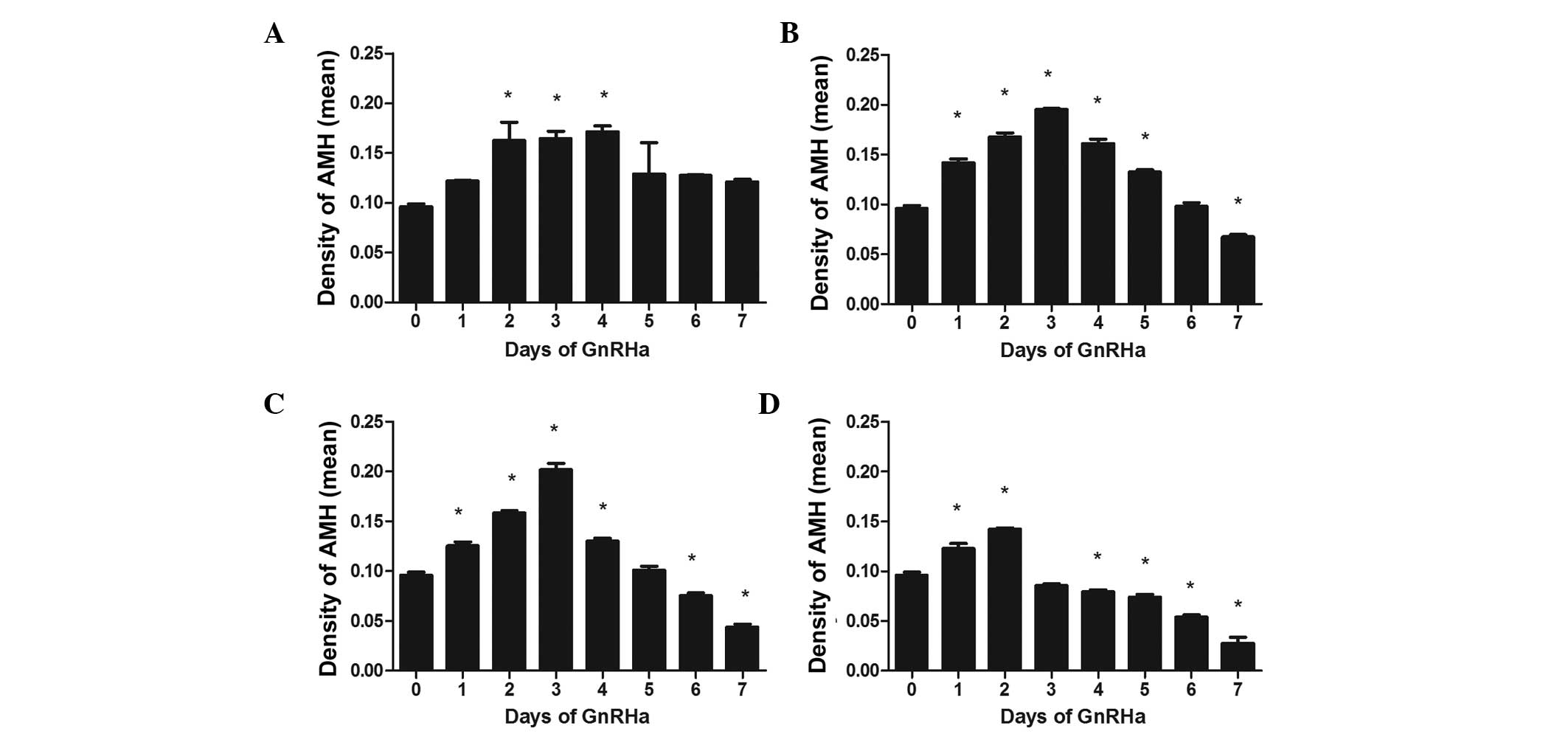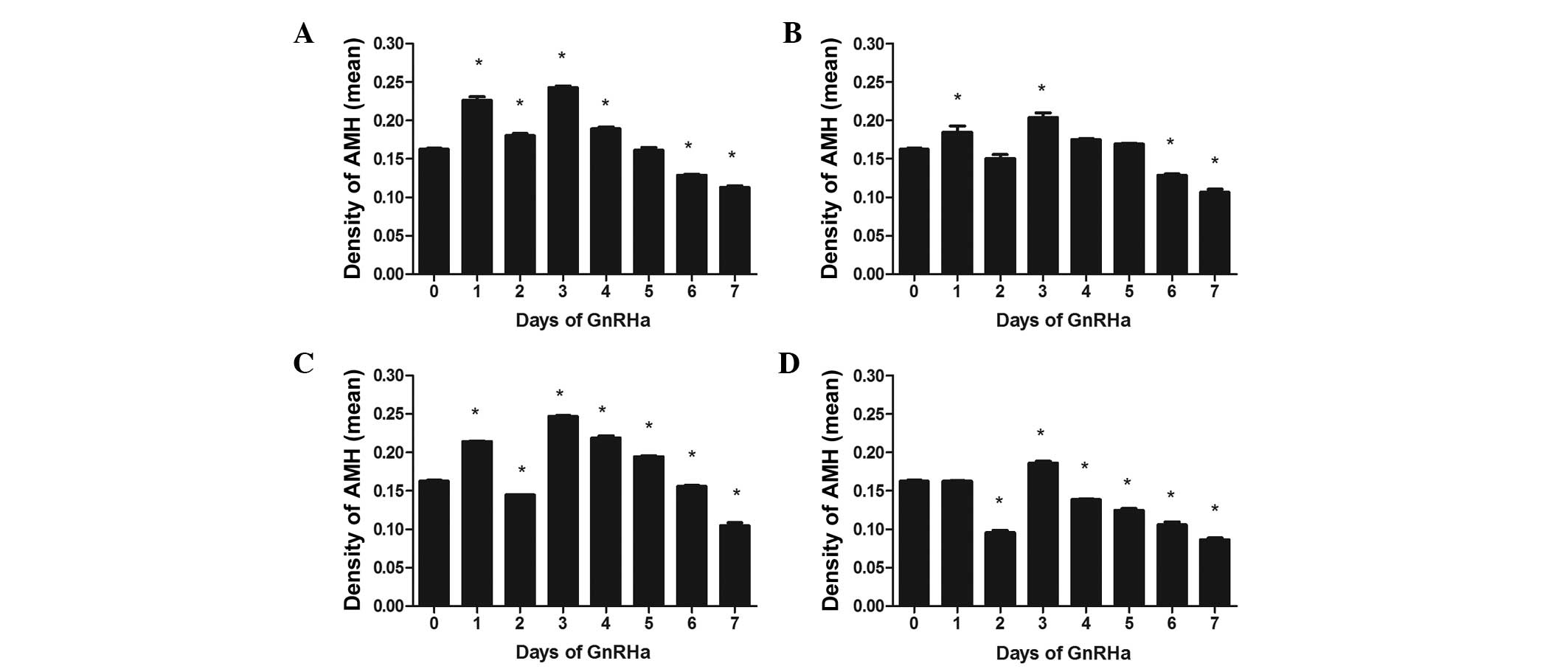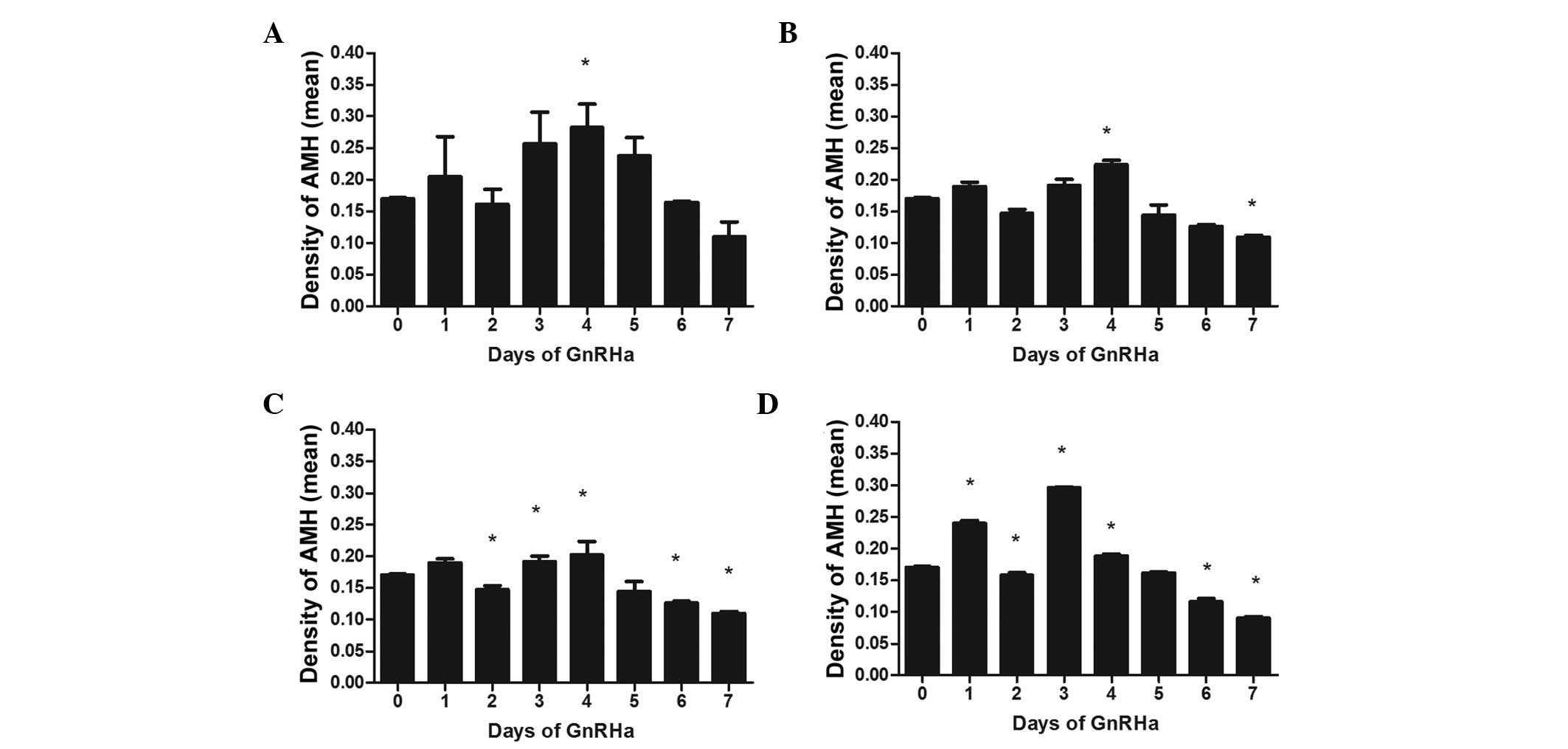|
1
|
Cate RL, Hession C, Tizard R, Farber NM,
Cheung A, Ninfa EG, Frey AZ, Gash DJ, Chow EP and Mattaliano RJ:
Isolation of the bovine and human genes for Müllerian inhibiting
substance and expression of the human gene in animal cells. Cell.
45:685–698. 1986. View Article : Google Scholar : PubMed/NCBI
|
|
2
|
Massague J: The transforming growth
factor-beta family. Annu Rev Cell Biol. 6:597–641. 1990. View Article : Google Scholar : PubMed/NCBI
|
|
3
|
Vigier B, Picard JY, Tran D, Legeai L and
Josso N: Production of anti-Müllerian hormone: another homology
between Sertoli and granulosa cells. Endocrinology. 114:1315–1320.
1984. View Article : Google Scholar : PubMed/NCBI
|
|
4
|
Munsterberg A and Lovell-Badge R:
Expression of the mouse anti-müllerian hormone gene suggests a role
in both male and female sexual differentiation. Development.
113:613–624. 1991.
|
|
5
|
Hirobe S, He WW, Lee MM and Donahoe PK:
Mullerian inhibiting substance messenger ribonucleic acid
expression in granulosa and sertoli cells coincides with their
mitotic activity. Endocrinology. 131:854–862. 1992.PubMed/NCBI
|
|
6
|
Ueno S, Takahashi M, Manganaro TF, Ragin
RC and Donahoe PK: Cellular localization of müllerian inhibiting
substance in the developing rat ovary. Endocrinology.
124:1000–1006. 1989. View Article : Google Scholar : PubMed/NCBI
|
|
7
|
Bézard J, Vigier B, Tran D, Mauléon P and
Josso N: Anti-müllerian hormone in sheep follicles. Reprod Nutr
Dev. 28:1105–1112. 1988. View Article : Google Scholar
|
|
8
|
Weenen C, Laven JS, Von Bergh AR,
Cranfield M, Groome NP, Visser JA, Kramer P, Fauser BC and Themmen
AP: Anti-Müllerian hormone expression pattern in the human ovary:
Potential implications for initial and cyclic follicle recruitment.
Mol Hum Reprod. 10:77–83. 2004. View Article : Google Scholar : PubMed/NCBI
|
|
9
|
Durlinger AL, Gruijters MJ, Kramer P,
Karels B, Ingraham HA, Nachtigal MW, Uilenbroek JT, Grootegoed JA
and Themmen AP: Anti-Mullerian hormone inhibits initiation of
primordial follicle growth in the mouse ovary. Endocrinology.
143:1076–1084. 2002.PubMed/NCBI
|
|
10
|
Durlinger AL, Kramer P, Karels B, de Jong
FH, Uilenbroek JT, Grootegoed JA and Themmen AP: Control of
primordial follicle recruitment by anti-Müllerian hormone in the
mouse ovary. Endocrinology. 140:5789–5796. 1999.PubMed/NCBI
|
|
11
|
Ha TU, Segev DL, Barbie D, Masiakos PT,
Tran TT, Dombkowski D, Glander M, Clarke TR, Lorenzo HK, Donahoe
PK, et al: Mullerian inhibiting substance inhibits ovarian cell
growth through an Rb-independent mechanism. J Biol Chem.
275:37101–37109. 2000. View Article : Google Scholar : PubMed/NCBI
|
|
12
|
di Clemente N, Ghaffari S, Pepinsky R,
Pieau C, Josso N, Cate RL and Vigier B: A quantitative and
interspecific test for biological activity of anti-mullerian
hormone: The fetal ovary aromatase assay. Development. 114:721–727.
1992.PubMed/NCBI
|
|
13
|
Teixeira J, Maheswaran S and Donahoe PK:
Müllerian inhibiting substance: An instructive developmental
hormone with diagnostic and possible therapeutic applications.
Endocr Rev. 22:657–674. 2001.PubMed/NCBI
|
|
14
|
Visser JA, de Jong FH, Laven JS and
Themmen AP: Anti-Müllerian hormone: A new marker for ovarian
function. Reproduction. 131:1–9. 2006. View Article : Google Scholar : PubMed/NCBI
|
|
15
|
Metallinou C, Asimakopoulos B, Schröer A
and Nikolettos N: Gonadotropin-releasing hormone in the ovary.
Reprod Sci. 14:737–749. 2007. View Article : Google Scholar : PubMed/NCBI
|
|
16
|
Schmutzler R, Reichert C, Diedrich K,
Wildt L, Diedrich C, Al-Hasani S, van der Ven H and Krebs D:
Combined GnRH-agonist/gonadotrophin stimulation for in-vitro
fertilization. Hum Reprod. 3:29–33. 1988. View Article : Google Scholar : PubMed/NCBI
|
|
17
|
Mohamed KA, Davies WA and Lashen H:
Antimüllerian hormone and pituitary gland activity after prolonged
down-regulation with goserelin acetate. Fertil Steril.
86:1515–1517. 2006. View Article : Google Scholar : PubMed/NCBI
|
|
18
|
Hagen CP, Sørensen K, Anderson RA and Juul
A: Serum levels of antimüllerian hormone in early maturing girls
before, during and after suppression with GnRH agonist. Fertil
Steril. 98:1326–1330. 2012. View Article : Google Scholar : PubMed/NCBI
|
|
19
|
Anderson RA, Themmen AP, Al-Qahtani A,
Groome NP and Cameron DA: The effects of chemotherapy and long-term
gonadotrophin suppression on the ovarian reserve in premenopausal
women with breast cancer. Hum Reprod. 21. pp. 2583–2592. 2006,
View Article : Google Scholar
|
|
20
|
Winkler N, Bukulmez O, Hardy DB and Carr
BR: Gonadotropin releasing hormone antagonists suppress aromatase
and anti-Müllerian hormone expression in human granulosa cells.
Fertil Steril. 94:1832–1839. 2010. View Article : Google Scholar
|
|
21
|
Seifer DB, MacLaughlin DT, Penzias AS,
Behrman HR, Asmundson L, Donahoe PK, Haning RV Jr and Flynn SD:
Gonadotropin-releasing hormone agonist-induced differences in
granulosa cell cycle kinetics are associated with alterations in
follicular fuid müllerian-inhibiting substance and androgen
content. J Clin Endocrinol Metab. 76:711–714. 1993.PubMed/NCBI
|
|
22
|
Britt KL, Saunders PK, McPherson SJ, Misso
ML, Simpson ER and Findlay JK: Estrogen actions on follicle
formation and early follicle development. Biol Reprod.
71:1712–1723. 2004. View Article : Google Scholar : PubMed/NCBI
|
|
23
|
Pelusi C, Ikeda Y, Zubair M and Parker KL:
Impaired follicle development and infertility in female mice
lacking steroidogenic factor 1 in ovarian granulosa cells. Biol
Reprod. 79:1074–1083. 2008. View Article : Google Scholar : PubMed/NCBI
|
|
24
|
Baarends WM, Uilenbroek JT, Kramer P,
Hoogerbrugge JW, van Leeuwen EC, Themmen AP and Grootegoed JA:
Anti-müllerian hormone and anti-müllerian hormone type II receptor
messenger ribonucleic acid expression in rat ovaries during
postnatal development, the estrous cycle and gonadotropin-induced
follicle growth. Endocrinology. 136:4951–4962. 1995.PubMed/NCBI
|
|
25
|
Takekida S, Matsuo H and Maruo T: GnRH
agonist action on granulosa cells at varying follicular stages. Mol
Cell Endocrinol. 202:155–164. 2003. View Article : Google Scholar : PubMed/NCBI
|
|
26
|
Billig H, Furuta I and Hsueh AJ:
Gonadotropin-releasing hormone directly induces apoptotic cell
death in the rat ovary: Biochemical and in situ detection of
deoxyribonucleic acid fragmentation in granulosa cells.
Endocrinology. 134:245–252. 1994.PubMed/NCBI
|
|
27
|
Diaz FJ, Wigglesworth K and Eppig JJ:
Oocytes are required for the preantral granulosa cell to cumulus
cell transition in mice. Dev Biol. 305:300–311. 2007. View Article : Google Scholar : PubMed/NCBI
|
|
28
|
Erickson GF, Hofeditz C, Unger M, Allen Wr
and Dulbecco R: A monoclonal antibody to a mammary cell Line
recognizes two distinct subtypes of ovarian granulosa
cells*. Endocrinology. 117:1490–1499. 1985. View Article : Google Scholar : PubMed/NCBI
|
|
29
|
Kawashima I, Okazaki T, Noma N, Nishibori
M, Yamashita Y and Shimada M: Sequential exposure of porcine
cumulus cells to FSH and/or LH is critical for appropriate
expression of steroidogenic and ovulation-related genes that impact
oocyte maturation in vivo and in vitro Reproduction. 136:9–21.
2008.
|
|
30
|
Grøndahl ML, Nielsen ME, Dal Canto MB,
Fadini R, Rasmussen IA, Westergaard LG, Kristensen SG and Yding
Andersen C: Anti-Müllerian hormone remains highly expressed in
human cumulus cells during the final stages of folliculogenesis.
Reprod Biomed Online. 22:389–398. 2011. View Article : Google Scholar
|
|
31
|
Albuquerque LE, Tso LO, Saconato H,
Albuquerque MC and Macedo CR: Depot versus daily administration of
gonadotrophin-releasing hormone agonist protocols for pituitary
down regulation in assisted reproduction cycles. Cochrane Database
Syst Rev. 1:CD0028082013.PubMed/NCBI
|
|
32
|
Li X, Kang X, Deng Q, Cai J and Wang Z:
Combination of a GnRH agonist with an antagonist prevents flare-up
effects and protects primordial ovarian follicles in the rat ovary
from cisplatin-induced toxicity: A controlled experimental animal
study. Reprod Biol Endocrinol. 11:162013. View Article : Google Scholar : PubMed/NCBI
|
|
33
|
Taieb J, Grynberg M, Pierre A, Arouche N,
Massart P, Belville C, Hesters L, Frydman R, Catteau-Jonard S,
Fanchin R, et al: FSH and its second messenger cAMP stimulate the
transcription of human anti-Müllerian hormone in cultured granulosa
cells. Mol Endocrinol. 25:645–655. 2011. View Article : Google Scholar : PubMed/NCBI
|
|
34
|
Thomas FH, Telfer EE and Fraser HM:
Expression of anti-Mullerian hormone protein during early
follicular development in the primate ovary in vivo is influenced
by suppression of gonadotropin secretion and inhibition of vascular
endothelial growth factor. Endocrinology. 148:2273–2281. 2007.
View Article : Google Scholar : PubMed/NCBI
|
|
35
|
Fanchin R, Taieb J, Lozano DH, Ducot B,
Frydman R and Bouyer J: High reproducibility of serum
anti-Müllerian hormone measurements suggests a multi-staged
follicular secretion and strengthens its role in the assessment of
ovarian follicular status. Hum Reprod. 20:923–927. 2005. View Article : Google Scholar : PubMed/NCBI
|
|
36
|
Fanchin R, Schonäuer LM, Righini C,
Frydman N, Frydman R and Taieb J: Serum anti-Müllerian hormone
dynamics during controlled ovarian hyperstimulation. Hum Reprod.
18:328–332. 2003. View Article : Google Scholar : PubMed/NCBI
|
|
37
|
Patsoula E, Loutradis D, Drakakis P,
Michalas L, Bletsa R and Michalas S: Messenger RNA expression for
the follicle-stimulating hormone receptor and luteinizing hormone
receptor in human oocytes and preimplantation-stage embryos. Fertil
Steril. 79:1187–1193. 2003. View Article : Google Scholar : PubMed/NCBI
|
|
38
|
Oktay K, Briggs D and Gosden RG: Ontogeny
of follicle-stimulating hormone receptor gene expression in
isolated human ovarian follicles 1. J Clin Endocrinol Metab.
82:3748–3751. 1997.PubMed/NCBI
|
|
39
|
Janssens RM, Brus L, Cahill DJ, Huirne JA,
Schoemaker J and Lambalk CB: Direct ovarian effects and safety
aspects of GnRH agonists and antagonists. Hum Reprod Update.
6:505–518. 2000. View Article : Google Scholar : PubMed/NCBI
|
|
40
|
Kang SK, Cheng KW, Nathwani PS, Choi K-C
and Leung PC: Autocrine role of gonadotropin-releasing hormone and
its receptor in ovarian cancer cell growth. Endocrine. 13:297–304.
2000. View Article : Google Scholar
|
|
41
|
Stojilkovic SS, Reinhart J and Catt KJ:
Gonadotropin-releasing hormone receptors: Structure and signal
transduction pathways. Endocr Rev. 15:462–499. 1994. View Article : Google Scholar : PubMed/NCBI
|
|
42
|
Hsueh AJ and Jones PB: Extrapituitary
actions of gonadotropin-releasing hormone. Endocr Rev. 2:437–461.
1981. View Article : Google Scholar : PubMed/NCBI
|
|
43
|
Schirman-Hildesheim TD, Ben-Aroya N and
Koch Y: Daily GnRH and GnRH-receptor mRNA expression in the
ovariectomized and intact rat. Mol Cell Endocrinol. 252:120–125.
2006. View Article : Google Scholar : PubMed/NCBI
|
|
44
|
Schirman-Hildesheim TD, Bar T, Ben-Aroya N
and Koch Y: Differential gonadotropin-releasing hormone (GnRH) and
GnRH receptor messenger ribonucleic acid expression patterns in
different tissues of the female rat across the estrous cycle.
Endocrinology. 146:3401–3408. 2005. View Article : Google Scholar : PubMed/NCBI
|
|
45
|
Singh P, K rishna A, Sridaran R and
Tsutsui K: Immunohistochemical localization of GnRH and
RFamide-related peptide-3 in the ovaries of mice during the estrous
cycle. J Mol Histol. 42:371–381. 2011. View Article : Google Scholar : PubMed/NCBI
|
|
46
|
Torrealday S, Lalioti MD,
Guzeloglu-Kayisli O and Seli E: Characterization of the
gonadotropin releasing hormone receptor (GnRHR) expression and
activity in the female mouse ovary. Endocrinology. 154:3877–3887.
2013. View Article : Google Scholar : PubMed/NCBI
|
|
47
|
Ranta T, Knecht M, Baukal AJ, Korhonen M
and Catt KJ: GnRH agonist-induced inhibitory and stimulatory
effects during ovarian follicular maturation. Mol Cell Endocrinol.
35:55–63. 1984. View Article : Google Scholar : PubMed/NCBI
|
|
48
|
Parborell F, Pecci A, Gonzalez O, Vitale A
and Tesone M: Effects of a gonadotropin-releasing hormone agonist
on rat ovarian follicle apoptosis: Regulation by epidermal growth
factor and the expression of Bcl-2-related genes. Biol Reprod.
67:481–486. 2002. View Article : Google Scholar : PubMed/NCBI
|
|
49
|
Park EJ, Shin JW, Seo YS, Kim DW, Hong SY,
Park WI and Kang BM: Gonadotropin-releasing hormone-agonist induces
apoptosis of human granulosa-luteal cells via caspase-8, -9 and -3
and poly-(ADP-ribose)-polymerase cleavage. Biosci Trends.
5:120–128. 2011. View Article : Google Scholar
|
|
50
|
Yu B, Ruman J and Christman G: The role of
peripheral gonadotropin-releasing hormone receptors in female
reproduction. Fertil Steril. 95:465–473. 2011. View Article : Google Scholar
|
|
51
|
Dong M, Huang L, Wang W, Du M, He Z, Mo Y
and Yang D: Regulation of AMH and SCF expression in human granulosa
cells by GnRH agonist and antagonist. Pharmazie. 66:436–439.
2011.PubMed/NCBI
|
|
52
|
McGee EA and Hsueh AJ: Initial and cyclic
recruitment of ovarian follicles. Endocr Rev. 21:200–214.
2000.PubMed/NCBI
|
|
53
|
Durlinger AL, Kramer P, Karels B, Kumar
TR, Matzuk MM, Rose UM, de Jong FH, Uilenbroek JT, Grootegoed JA,
Themmen AP, et al: Anti-Müllerian hormone attenuates the effects of
FSH on follicle development in the mouse ovary. Endocrinology.
142:4891–4899. 2001.PubMed/NCBI
|
|
54
|
Pellatt L, Rice S, Dilaver N, Heshri A,
Galea R, Brincat M, Brown K, Simpson ER and Mason HD:
Anti-Müllerian hormone reduces follicle sensitivity to
follicle-stimulating hormone in human granulosa cells. Fertil
Steril. 96:1246–1251. 2011. View Article : Google Scholar
|
|
55
|
di Clemente N, Goxe B, Remy JJ, Cate RL,
Josso N, Vigier B and Salesse R: Inhibitory effect of AMH upon the
expression of aromatase activity and LH receptors by cultured GCsof
rat and porcine immature ovaries. Endocrine. 2:553–558. 1994.
|
|
56
|
Eppig JJ: Oocyte control of ovarian
follicular development and function in mammals. Reproduction
(Cambridge, England). 122:829–838. 2001. View Article : Google Scholar
|
|
57
|
Devjak R1, Fon Tacer K, Juvan P, Virant
Klun I, Rozman D and Bokal E: Cumulus cells gene expression
profiling in terms of oocyte maturity in controlled ovarian
hyperstimulation using GnRH agonist or GnRH antagonist. PLoS One.
7:e471062012. View Article : Google Scholar : PubMed/NCBI
|
|
58
|
Kedem-Dickman A, Maman E, Yung Y, Yer
ushalmi GM, Hemi R, Hanochi M, Dor J and Hourvitz A: Anti-Müllerian
hormone is highly expressed and secreted from cumulus granulosa
cells of stimulated preovulatory immature and atretic oocytes.
Reprod Biomed Online. 24:540–546. 2012. View Article : Google Scholar : PubMed/NCBI
|
|
59
|
Cook CL, Siow Y, Taylor S and Fallat ME:
Serum müllerian-inhibiting substance levels during normal menstrual
cycles. Fertil Steril. 73:859–861. 2000. View Article : Google Scholar : PubMed/NCBI
|
|
60
|
Lee MM and Donahoe PK: Mullerian
inhibiting substance: A gonadal hormone with multiple functions.
Endocr Rev. 14:152–164. 1993.PubMed/NCBI
|
|
61
|
Vasudevan K and Sztein JM: In vitro
fertility rate of 129 strain is improved by buserelin
(gonadotropin-releasing hormone) administration prior to
superovulation. Lab Anim. 46:299–303. 2012. View Article : Google Scholar : PubMed/NCBI
|















